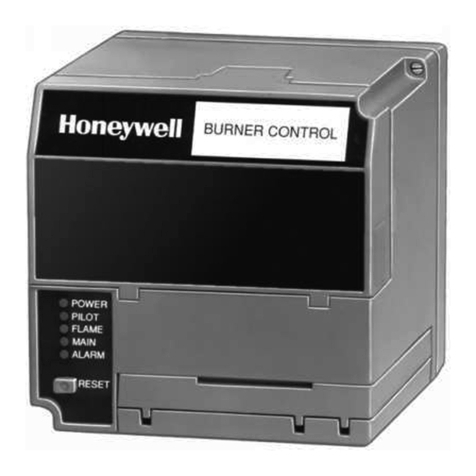
CB780E/CB784E RELAY MODULES WITH VALVE PROVING
32-00150—03 8 750-234
purge or opens during purge. The CB780E/CB784E will
lockout and annunciate an alarm if the switch fails to
close within the hold time period.
Low Fire Start Switch Test examines the Low Fire Start
Switch at the moment PREPURGE is completed. If the
switch is bypassed, welded or otherwise prematurely
closed, the system automatically adds 30 seconds to allow
the firing rate motor additional time to reach or near the
low fire start position before ignition trials; otherwise,
ignition trials start after the Low Fire Switch closes. The
test also is used to prove that the firing rate motor is at low
fire position throughout the ignition trial period. This
switch will also cause a hold (four minutes, fifteen
seconds) condition if the switch opens after purging is
complete. The CB780E/CB784E will lockout and
annunciate an alarm if the switch fails to close within the
hold time period.
Mandatory Purge
If lockout occurs after the initiation of ignition trials, (or at
anytime during a sequence when the fuel valves may have
been energized), a mandatory POSTPURGE period is
imposed.
Off Cycle (STANDBY or PREPURGE)
Flame Signal Check
The flame detection subsystem (flame detector and
amplifier) is monitored during STANDBY. If a flame
simulating condition or an actual flame exists, a system
hold occurs and start-up is prevented. If the flame signal
exists at any time after the first 40 seconds of STANDBY, a
safety shutdown will occur and be annunciated. A shutter-
check amplifier and self-checking detector are energized
for the first 40 seconds during STANDBY and the last two
seconds before exiting STANDBY. If a flame exists, a safety
shutdown occurs. An AMPLI-CHECK™ Amplifier is
energized continually through STANDBY and PREPURGE
to detect any possibility of a runaway detector or a flame. If
either situation happens, a safety shutdown occurs. A
standard amplifier is energized continually through
STANDBY and PREPURGE. If either situation happens, a
safety shutdown occurs.
Preignition Output Circuit Check
At the end of PREPURGE, the Dynamic Safety Relay
operation is checked. Also, all safety critical loads,
terminals 8, 9, 10 and 21 are checked to verify the
terminals are not powered. If the Dynamic Safety Relay
operation is faulty, or if any of the safety critical loads are
powered, safety shutdown occurs and is annunciated.
Tamper-Resistant Timing and Logic
Safety and logic timings are inaccessible and cannot be
altered or defeated.
Verified Spark Termination
The ignition terminal is monitored to verify early spark
termination (five seconds ignition and pilot and five
seconds pilot only).
First-Out Annunciation and Self-
Diagnostics
Sequence Status Lights (LEDs) provide positive visual
indication of the program sequence: POWER, PILOT,
FLAME, MAIN and ALARM. The green POWER LED blinks
every four seconds to signify the CB780E/CB784E
hardware is running correctly.
Multi-function Keyboard Display Module (standard with
CB780E, optional with CB784E) shows elapsed time
during PREPURGE, PILOT IGN, MAIN IGN, and
POSTPURGE. As an additional troubleshooting aid, it
provides sequence timing, diagnostic information,
historical information and expanded annunciator
information when a safety shutdown or hold or normal
operation occurs.
First-out Annunciation reports the cause of a safety
shutdown or identifies the cause of a failure to start or
continue the burner control sequence with an English text
and numbered code via the Keyboard Display Module. It
monitors all field input circuits, including the Flame
Signal Amplifier and Firing Rate Position Switches. The
system distinguishes 118 modes of failure and detects
and annunciates difficult-to-find intermittent failures.
Self-Diagnostics adds to the First-out Annunciation by
allowing the CB780E/CB784E to distinguish between
field (external device) and internal (system related)
problems. Faults associated within the flame detection
subsystem, CB780E/CB784E or plug-in Purge Card, are
isolated and reported by the Keyboard Display Module,
see Troubleshooting section and CB780E/CB784E
System Annunciation Diagnostics and Troubleshooting,
Bulletin Number CB-7803.
Interlock Requirements
The following interlock inputs are provided:
Low Fire Interlock
This interlock verifies the firing rate motor is in the low fire
position before and during ignition trials.
High Fire Interlock
This interlock verifies the firing rate motor is in the high
fire position prior to and during PREPURGE.
Lockout Interlock
This interlock (ILK) input signifies a Lockout Interlock. If
the Lockout Interlock is open for more than ten seconds
into PREPURGE, the CB780E/CB784E will lockout. After
entering PREPURGE, if the Lockout Interlock opens
during the first ten seconds, the purge timer will be reset.
This provides a continuous PURGE to occur without
interruption before the Pilot Flame Establishing Period. If
a Lockout Interlock opens anytime after ten seconds into
PURGE, during the Ignition Trials or Run, it causes a
lockout.
A typical Lockout Interlock string contains an airflow
switch (see Fig. 8). The Interlock Check is a site
configurable option (see Table 7). If this feature is enabled,
the CB780E/CB784E will lockout after 120 seconds





























